ENSAYOS
ESSAYS
Desde Manhattan: Visiones a contracorriente
New York: Five Points, 2025, 492 páginas
La pérdida del respeto a las instituciones, al no haber sabido representar los intereses del colectivo, ha motorizado las protestas, que desde 2019 tienen como denominador común el colapso del crecimiento económico con graves consecuencias para el desarrollo de los países, especialmente en las regiones más desasistidas. Ello ha minado la confianza en la idea de progreso, poniendo a la mayoría en situación de precariedad extrema, en tanto que el uno por ciento restante ha terminado detentando aproximadamente la mitad de la riqueza mundial.
Esta abrumadora discordancia en la era de las conexiones ilimitadas e instantáneas ha unido a la mayoría silenciosa, llevándola a manifestarse masivamente contra las intolerancias resultantes de tal disparidad. La represión estatal ha sido feroz en las dictaduras, aunque muchos países democráticos han tratado también de silenciarlas presionados por los sectores influyentes; especialmente el del capital trasnacional, cuyo ascendente en los asuntos de Estado es de muy largo alcance en Latinoamérica.
Esta colección de entrevistas y ensayos publicados en diferentes antologías, periódicos y revistas en los últimos 10 años, acercan al lector a importantes temas de nuestra contemporaneidad, en un tiempo cuando la libertad de expresión está bajo acoso, debido al aumento de las autocracias y la validación de las intolerancias por parte del poder público. Literatura, cine, arte, teatro y moda se aúnan a las reflexiones de distintos creadores, para mostrar un espectro amplio de ideas en torno a las voces marginadas del discurso dominante; ya sean estas la mujer o las minorías étnicas y sexuales. Todo ello a contracorriente y con la isla de Manhattan como marco.
The erosion of respect for institutions, stemming from their failure to represent collective interest, has fueled protests that, since 2019, have shared a common denominator: the collapse of economic growth, with severe consequences for national development, particularly in the most underserved regions. This has undermined faith in the notion of progress, pushing the majority into extreme precarity, while the wealthiest one percent has come to control nearly half of the world’s resources.
In an era of unlimited and instant connectivity, this stark disparity has united the silent majority, driving them to mobilize en masse against the injustices born of such inequality. State repression has been brutal in dictatorships, but even many democratic governments—under pressure from powerful interests, particularly transnational capital, whose influence over state affairs runs deep in Latin America—have sought to suppress these movements.This collection of interviews and essays, originally published in anthologies, newspapers, and magazines over the past decade, offers readers a window into some of the most pressing issues of our time—an era in which freedom of expression is under siege, threatened by the rise of autocracies and the legitimization of intolerance by those in power. Literature, film, art, theater, and fashion intertwine with the reflections of diverse creators, forming a rich tapestry of ideas that amplify voices marginalized by the dominant discourse—whether women, ethnic or sexual minorities. All of this, against the tide and with the Island of Manhattan as the backdrop.
Cámara, acción, reacción. Cine e intolerancia en Iberoamérica
Berlín: Peter Lang, 2021, 191 páginas.
La incertidumbre en el mañana como constante de esta contemporaneidad se ha agudizado, dada la profunda desigualdad social que las estructuras políticas y financieras han provocado en el nuevo milenio, trayendo más pobreza, violencia e intolerancia. El terrorismo, las limpiezas étnicas, el fanatismo religioso, la destrucción del ecosistema, los nuevos virus, la reaparición de enfermedades que parecían haberse erradicado, se aúnan a la falta de perspectivas.
Este estudio tiene como objetivo reflexionar acerca de diversas formas de intolerancia, tal como se presentan en una serie de películas de la filmografía hispanoamericana y española. Los abusos de la Iglesia Católica, el racismo, el sexismo, la xenofobia, los autoritarismos, la corrupción política y económica, la homofobia y la violencia contra las minorías encuentran su lugar en estas páginas. La inestabilidad global y sus repercusiones en las sociedades de habla hispana enmarcan las reflexiones y el análisis en torno a los films incluidos, ofreciendo un espectro amplio de visiones sobre los sectarismos en un mundo cada vez más virtual y polarizado.
The persistent uncertainty about the future in this contemporaneity has become more critical, given the deep social inequality that the political and financial systems have triggered in the new millennium, bringing about more poverty, violence, and intolerance. Terrorism, ethnic cleansing, religious fanaticism, the destruction of the ecosystem, new viruses, the reappearance of diseases thought to have been eradicated, merge with the lack of prospects.
The objective of this study is to reflect on different forms of intolerance, as they are shown in a cluster of films of Spanish-American and Spanish filmography. The abuses of the Catholic Church, racism, sexism, xenophobia, authoritarianism, political and economic corruption, homophobia, and violence against minorities are at the core of these pages. Global instability and its effects on Spanish-speaking societies frame the reflections and the analysis of the films being examined, offering a broad spectrum of views on sectarianism in an increasingly virtual and polarized world.
Introducción
Presentación Zoom
Cine e intolerancia: una mirada a nuestra contemporaneidad
Nora Glickman entrevista a Alejandro Varderi
Entrevista para la revista Imagofagia por Nora Glickman:
Entrevista Club 23
Presentación Zoom
Cine e intolerancia: una mirada a nuestra contemporaneidad
Nora Glickman entrevista a Alejandro Varderi
Entrevista para la revista Imagofagia por Nora Glickman:
Entrevista Club 23
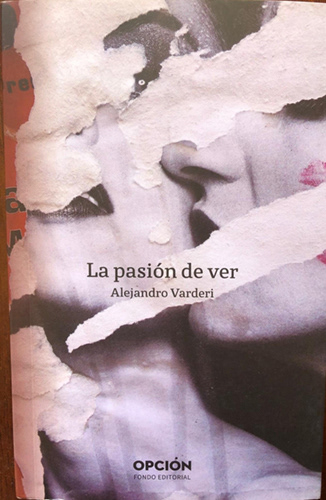
La pasión de ver: imágenes de la literatura y las artes
México: ITAM, 2018, 417 páginas.
En la hipermodernidad la obra ya no es el espejo de quien la produce, pues descentrar la literatura, el arte, el cine, de la persona, deseos y gustos del autor conlleva un proceso donde la originalidad de la misma está en otra parte. El crítico no observa a través de la obra sino desde ella, cuando busca abordar ese elusivo objeto que permanece suspendido en un espacio neutro, deslastrado de los vicios y virtudes de su hacedor.
Esta colección de ensayos escrita a lo largo de varias décadas de miradas a la literatura, el arte, la ciudad, el teatro y el cine, aborda diversas preocupaciones contemporáneas tales como los nacionalismos, los caudillismos, la homofobia y la xenofobia. A partir de las obras estudiadas, se teje una reflexión en torno a los problemas que afectan globalmente el devenir de nuestros países y la vida de sus habitantes.
In hypermodernity, the work is no longer the mirror of the one who produces it. Decentralizing literature, art, cinema, from the being, desires and tastes of the author entails a process where its originality lays elsewhere. The critic does not observe through the work but from it, when he seeks to address that elusive object, which remains suspended in a neutral space, detached from the vices and virtues of its maker.
This collection of essays written over several decades of gazing at literature, art, the city, theater and cinema, addresses numerous contemporary worries such as nationalisms, despotisms, homophobia and xenophobia. From the works studied, a reflection is woven around the problems that globally affect the future of our countries and the lives of their inhabitants.
Leer
México: ITAM, 2018, 417 páginas.
En la hipermodernidad la obra ya no es el espejo de quien la produce, pues descentrar la literatura, el arte, el cine, de la persona, deseos y gustos del autor conlleva un proceso donde la originalidad de la misma está en otra parte. El crítico no observa a través de la obra sino desde ella, cuando busca abordar ese elusivo objeto que permanece suspendido en un espacio neutro, deslastrado de los vicios y virtudes de su hacedor.
Esta colección de ensayos escrita a lo largo de varias décadas de miradas a la literatura, el arte, la ciudad, el teatro y el cine, aborda diversas preocupaciones contemporáneas tales como los nacionalismos, los caudillismos, la homofobia y la xenofobia. A partir de las obras estudiadas, se teje una reflexión en torno a los problemas que afectan globalmente el devenir de nuestros países y la vida de sus habitantes.
In hypermodernity, the work is no longer the mirror of the one who produces it. Decentralizing literature, art, cinema, from the being, desires and tastes of the author entails a process where its originality lays elsewhere. The critic does not observe through the work but from it, when he seeks to address that elusive object, which remains suspended in a neutral space, detached from the vices and virtues of its maker.
This collection of essays written over several decades of gazing at literature, art, the city, theater and cinema, addresses numerous contemporary worries such as nationalisms, despotisms, homophobia and xenophobia. From the works studied, a reflection is woven around the problems that globally affect the future of our countries and the lives of their inhabitants.
Leer
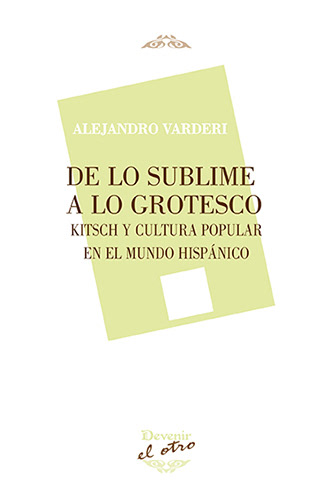
De lo sublime a lo grotesco: kitsch y cultura popular en el mundo hispánico
Madrid: Devenir, 2015, 245 páginas.
El lugar que ocupa le estética del kitsch en las representaciones artísticas, literarias y cinemáticas del mundo hispánico tiene, en ese movimiento de traslación llevándolas de lo sublime a lo grotesco sin transiciones, su expresión más certera. Ello, dadas las características primordiales del ser nuestro, propenso a los cambios intempestivos de humor, y a la tendencia de privilegiar la pasión por encima de la razón, al momento de tomar cualquier decisión.
Este estudio aborda la obra de artistas, narradores y cineastas partiendo de la estética del kitsch. Una estética que, si en líneas generales, para el español viene asociada con el exceso y el cachondeo, al otro lado del Atlántico deposita también la ilusión de quienes lo ubican en el altar de la esperanza; ello buscando escapar de conquistas, colonialismos, caudillismos, populismos y dictaduras, culpables de mantener a Hispanoamérica constreñida entre la miseria y el atraso.
The place that kitsch aesthetics occupy in the artistic, literary and cinematic representations of the Hispanic world has, in that translational movement taking them from the sublime to the grotesque without transitions, their most accurate expression. This, given the essential traits of our being, which is prone to untimely mood swings, and has the tendency to favor passion over reason when making any decision.
This study deals with works of artists, novelists and filmmakers from the kitsch aesthetics point of view. An aesthetic that, in general terms, if for Spaniards is connected to excess and derision, on the other side of the Atlantic it also preserves the illusions of those who place it on the altar of hope; this seeking to flee from conquests, colonialism, despotisms, populisms and dictatorships, guilty of keeping Latin America constrained between misery and backwardness.
Madrid: Devenir, 2015, 245 páginas.
El lugar que ocupa le estética del kitsch en las representaciones artísticas, literarias y cinemáticas del mundo hispánico tiene, en ese movimiento de traslación llevándolas de lo sublime a lo grotesco sin transiciones, su expresión más certera. Ello, dadas las características primordiales del ser nuestro, propenso a los cambios intempestivos de humor, y a la tendencia de privilegiar la pasión por encima de la razón, al momento de tomar cualquier decisión.
Este estudio aborda la obra de artistas, narradores y cineastas partiendo de la estética del kitsch. Una estética que, si en líneas generales, para el español viene asociada con el exceso y el cachondeo, al otro lado del Atlántico deposita también la ilusión de quienes lo ubican en el altar de la esperanza; ello buscando escapar de conquistas, colonialismos, caudillismos, populismos y dictaduras, culpables de mantener a Hispanoamérica constreñida entre la miseria y el atraso.
The place that kitsch aesthetics occupy in the artistic, literary and cinematic representations of the Hispanic world has, in that translational movement taking them from the sublime to the grotesque without transitions, their most accurate expression. This, given the essential traits of our being, which is prone to untimely mood swings, and has the tendency to favor passion over reason when making any decision.
This study deals with works of artists, novelists and filmmakers from the kitsch aesthetics point of view. An aesthetic that, in general terms, if for Spaniards is connected to excess and derision, on the other side of the Atlantic it also preserves the illusions of those who place it on the altar of hope; this seeking to flee from conquests, colonialism, despotisms, populisms and dictatorships, guilty of keeping Latin America constrained between misery and backwardness.
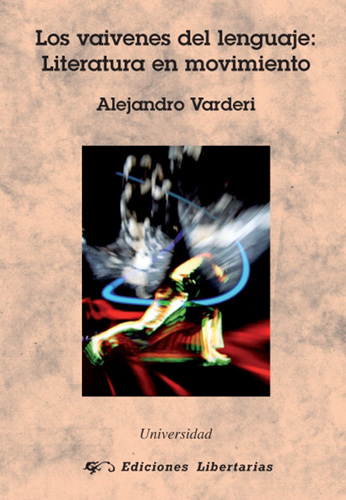
Los vaivenes del lenguaje: literatura en movimiento
Madrid: Libertarias, 2011, 236 páginas.
Admitir la validez del crítico como escritor; de ojo que recorre con un lenguaje paralelo el primer lenguaje constructor del texto, implica llevarlo al terreno del creador donde dicho crítico deberá asumir una postura totalizadora, envolvente en todo sentido y tensión.
Esta colección recoge una serie de ensayos donde cada tema, desde los Bestiarios medievales hasta las obras de determinados autores contemporáneos como René Char y Mario Vargas Llosa, se aborda atendiendo a un tipo de funcionamiento del lenguaje en que, como indica Julia Kristeva, “el sentido no se lee en el hilo del discurso sino en su espesor”.
To acknowledge the legitimacy of the critic as writer; as the eye that follows with a parallel language the first language that constructs the text, means to take it into the authors’ realm where such critic must assume a totalizing posture, enveloping in every way and tension.
This collection gathers a group of essays where each topic, from the medieval Bestiaries to the works of certain contemporary authors such as René Char and Mario Vargas Llosa, is approached according to a kind of language maneuver in which, as Julia Kristeva indicates, “the meaning is not read in the thread of the speech but in its thickness.”
Madrid: Libertarias, 2011, 236 páginas.
Admitir la validez del crítico como escritor; de ojo que recorre con un lenguaje paralelo el primer lenguaje constructor del texto, implica llevarlo al terreno del creador donde dicho crítico deberá asumir una postura totalizadora, envolvente en todo sentido y tensión.
Esta colección recoge una serie de ensayos donde cada tema, desde los Bestiarios medievales hasta las obras de determinados autores contemporáneos como René Char y Mario Vargas Llosa, se aborda atendiendo a un tipo de funcionamiento del lenguaje en que, como indica Julia Kristeva, “el sentido no se lee en el hilo del discurso sino en su espesor”.
To acknowledge the legitimacy of the critic as writer; as the eye that follows with a parallel language the first language that constructs the text, means to take it into the authors’ realm where such critic must assume a totalizing posture, enveloping in every way and tension.
This collection gathers a group of essays where each topic, from the medieval Bestiaries to the works of certain contemporary authors such as René Char and Mario Vargas Llosa, is approached according to a kind of language maneuver in which, as Julia Kristeva indicates, “the meaning is not read in the thread of the speech but in its thickness.”
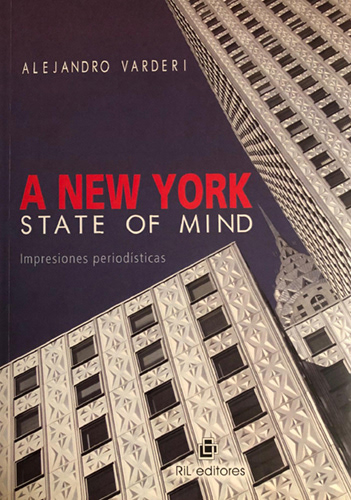
A New York State of Mind
Santiago de Chile: RIL, 2008, 202 páginas.
A pesar de tantas mutaciones, Nueva York sigue siendo la ciudad más sola del mundo; la diferencia estriba en que esas soledades ni se drogan ni fuman ni beben ni tienen tanto sexo como antes. Manhattan es demasiado caro y complaciente. La gente que motorizaba la diversión más ingeniosa en los clubs y las extravagantes fiestas se ha esfumado.
Estas “impresiones periodísticas”, flashes de la ciudad y lo que la ciudad contiene, cubren dos décadas (1985-2005) de eventos, conversaciones, artistas y autores que temporal o permanentemente han hecho de Nueva York su laboratorio particular, para que el lector también participe, aunque sea vicariamente, de la vida urbana como espectáculo.
In spite of too many mutations, New York is still the loneliest city in the world. The difference is that those solitudes don’t take drugs, smoke, drink or have as much sex as they did in the past. Manhattan is too expensive and self-satisfied. Those who fueled the wittiest entertainment in the clubs and the outrageous parties have vanished.
These “journalistic impressions,” flashes of the city and what the city contains, span two decades (1985-2005) of events, conversations, artists and authors who, temporally or permanently, have made of New York their private laboratory, letting the reader to participate, even if only vicariously, in the urban life as spectacle.
Santiago de Chile: RIL, 2008, 202 páginas.
A pesar de tantas mutaciones, Nueva York sigue siendo la ciudad más sola del mundo; la diferencia estriba en que esas soledades ni se drogan ni fuman ni beben ni tienen tanto sexo como antes. Manhattan es demasiado caro y complaciente. La gente que motorizaba la diversión más ingeniosa en los clubs y las extravagantes fiestas se ha esfumado.
Estas “impresiones periodísticas”, flashes de la ciudad y lo que la ciudad contiene, cubren dos décadas (1985-2005) de eventos, conversaciones, artistas y autores que temporal o permanentemente han hecho de Nueva York su laboratorio particular, para que el lector también participe, aunque sea vicariamente, de la vida urbana como espectáculo.
In spite of too many mutations, New York is still the loneliest city in the world. The difference is that those solitudes don’t take drugs, smoke, drink or have as much sex as they did in the past. Manhattan is too expensive and self-satisfied. Those who fueled the wittiest entertainment in the clubs and the outrageous parties have vanished.
These “journalistic impressions,” flashes of the city and what the city contains, span two decades (1985-2005) of events, conversations, artists and authors who, temporally or permanently, have made of New York their private laboratory, letting the reader to participate, even if only vicariously, in the urban life as spectacle.

Anatomía de una seducción: reescrituras de lo femenino
Primera edición. Caracas: Academia Nacional de la Historia, 1996, 290 páginas.
Primera edición. Caracas: Academia Nacional de la Historia, 1996, 290 páginas.
Segunda edición. Santiago de Chile: RIL, 2013, 160 páginas.
Si la mujer ha puesto a prueba sus destrezas escribiéndose desde sí misma y el otro, es interesante observar también cómo el hombre ha abordado lo femenino, en este mundo de “simulaciones controladas” donde nos ha tocado vivir, especialmente dentro de la periferia latinoamericana, siempre a la zaga de los procesos surgidos en las naciones industrializadas.
Este libro es un recorrido por la poesía y la narrativa iberoamericana en torno a lo femenino, hechas por mujeres o por hombres cuya sensibilidad les permite hacerse con el otro sexo. Santa Teresa de Jesús, Sor Juana Inés de la Cruz, Mercè Rodoreda, Victoria Ocampo, Manuel Puig y Evelio Rosero Diago son algunas de las voces estudiadas. Cine, teatro, danza y cultura popular se imbrican igualmente en el entramado de los ensayos universalizando con ello los contenidos.
Si la mujer ha puesto a prueba sus destrezas escribiéndose desde sí misma y el otro, es interesante observar también cómo el hombre ha abordado lo femenino, en este mundo de “simulaciones controladas” donde nos ha tocado vivir, especialmente dentro de la periferia latinoamericana, siempre a la zaga de los procesos surgidos en las naciones industrializadas.
Este libro es un recorrido por la poesía y la narrativa iberoamericana en torno a lo femenino, hechas por mujeres o por hombres cuya sensibilidad les permite hacerse con el otro sexo. Santa Teresa de Jesús, Sor Juana Inés de la Cruz, Mercè Rodoreda, Victoria Ocampo, Manuel Puig y Evelio Rosero Diago son algunas de las voces estudiadas. Cine, teatro, danza y cultura popular se imbrican igualmente en el entramado de los ensayos universalizando con ello los contenidos.
Since woman has showed her skills writing from herself and from the other, it is also interesting to observe how man has addressed the feminine, in this “world of controlled simulations” where we live. This, being specially the case in the Latin American periphery, which is always lagging behind the industrialized nations.
This book is a journey through feminine Ibero-American poetry and narrative written by women or by men whose sensibility lets them write from the other’s sex. Santa Teresa de Jesús, Sor Juana Inés de la Cruz, Mercè Rodoreda, Victoria Ocampo, Manuel Puig and Evelio Rosero Diago are some of the voices being studied. Cinema, dance and popular culture are also embedded in the framework of the essays, universalizing the contents.
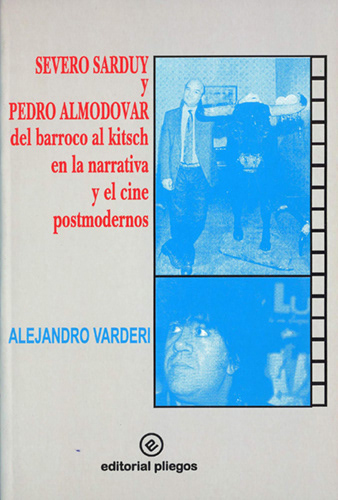
Severo Sarduy y Pedro Almodovar: del barroco al kitsch en la narrativa y el cine postmodernos
Madrid: Pliegos 1996, 233 páginas.
Ambos creadores comulgan en la kitschifización de lo establecido y la consagración de la desmesura, artificializando lo popular hasta llevarlo al hiperreal y rescatar, para la generación postmoderna, el kitsch que no han vivido.
Este estudio crítico es una reflexión en torno a las novelas del autor cubano Severo Sarduy y las películas del cineasta español Pedro Almodóvar partiendo de la estética del kitsch. La narrativa neobarroca hispanoamericana y el cine español de la dictadura franquista, sirven de marco a las obras y al modo como estas abordan la ciudad, la casa y el cuerpo, desde la cultura popular y las diferencias tanto sexuales como de género.
Este estudio crítico es una reflexión en torno a las novelas del autor cubano Severo Sarduy y las películas del cineasta español Pedro Almodóvar partiendo de la estética del kitsch. La narrativa neobarroca hispanoamericana y el cine español de la dictadura franquista, sirven de marco a las obras y al modo como estas abordan la ciudad, la casa y el cuerpo, desde la cultura popular y las diferencias tanto sexuales como de género.
Both artists aim to kitschify the establishment and to consecrate excess, artificializing the popular and carrying it to the hyperreal, in order to recover, for the postmodern generation, the kitsch they have not lived.
This critical study is a reflection upon the novels by Cuban author Severo Sarduy and the films by Spanish filmmaker Pedro Almodóvar, with kitsch aesthetics as the point of departure. The Spanish American Neo-baroque narrative and the Spanish filmography of the Francoist dictatorship build the framework and shape the way in which novels and films address the city, the house and the body. Popular culture, and gender and sexual differences are also studied in connection with the works.
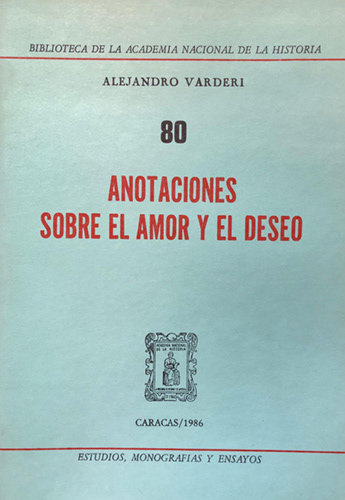
Anotaciones sobre el amor y el deseo
Caracas: Academia Nacional de la Historia, 1986, 140 páginas.
Querella se aparta de los restantes personajes en la narrativa de Jean Genet —Divers, Bulkaen, Divina, Harcamone— quienes, como lo ángeles del Apocalipsis poseían, por su crueldad, el poder de hacer daño con su belleza; si bien al igual que el mismo Querella, se conservaban en estado puro.
Este libro es un acercamiento amoroso a la literatura, el cine y la danza, partiendo de la obra de figuras tales como Marcel Proust, Vaslav Nijinsky, Rainer Werner Fassbinder y Reynaldo Hahn. Autores venezolanos como Rafael Cadenas, Juan Calzadilla, Elisa Lerner y Hanni Ossot encuentra también su lugar en estas páginas. Todo ello, buscando crear una zona de roces y atracciones entre la voz del autor y el objeto abordado, para reflexionar acerca del papel del amor y el deseo en la realización de las obras.
Querella diverts from the rest of Jean Genet’s characters —Divers, Bulkaen, Divina, Harcamone— that, in their cruelty, like the Apocalypses’ angels had the power of wounding with their beauty, though were kept in a state of purity as Querella himself.
This book is a loving approach to literature, film and dance in the oeuvres of authors and artists such as Marcel Proust, Vaslav Nijinsky, Rainer Werner Fassbinder and Reynaldo Hahn. Venezuelan writers Rafael Cadenas, Juan Calzadilla Elisa Lerner and Hanni Ossot, among others, also find their place in these pages. In all, this study seeks to create an area of frictions and attractions, between the author and his object, and to reflect upon the role of love and desire in the making of the works.
This book is a loving approach to literature, film and dance in the oeuvres of authors and artists such as Marcel Proust, Vaslav Nijinsky, Rainer Werner Fassbinder and Reynaldo Hahn. Venezuelan writers Rafael Cadenas, Juan Calzadilla Elisa Lerner and Hanni Ossot, among others, also find their place in these pages. In all, this study seeks to create an area of frictions and attractions, between the author and his object, and to reflect upon the role of love and desire in the making of the works.
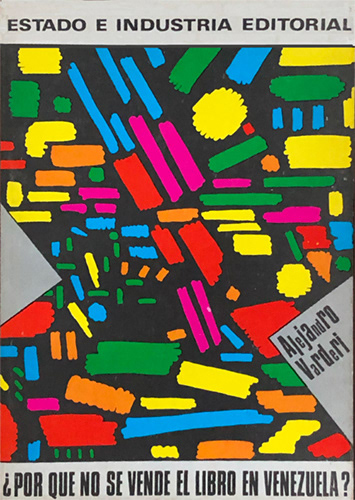
Estado e industria editorial: ¿Por qué no se vende el libro en Venezuela?
Caracas: Fundarte, 1985, 190 páginas.
En nada contribuye a la evolución cultural del país, el seguir publicando y que las ediciones queden prácticamente intactas en los depósitos; no solo porque las editoriales del Estado no poseen las infraestructuras básicas para penetrar agresivamente el mercado, sino porque tanto el librero como el impresor y el público consumidor, constituyen entes pasivos dentro del circuito de comercialización.
Este estudio aborda los problemas de oferta, demanda y comercialización del libro editado por las editoriales del Estado. Monte Ávila Editores, Imprenta Universitaria de la Universidad Central de Venezuela, Biblioteca Ayacucho, Editorial Equinoccio de la Universidad Simón Bolívar y Fundarte son las editoriales estudiadas. Igualmente, se realiza una comparación entre el funcionamiento de las editoriales estatales y la editorial privada Gráficas Armitano, además de ubicar las editoriales venezolanas en el contexto editorial hispanoamericano.
To continue publishing and to leave the editions practically intact in storage does not contribute to the country’s cultural growth; not only because government publishing houses lack basic infrastructures to aggressively penetrate the markets, but also because the bookseller, the printing man, and the consumer become passive entities within the commercialization circuit.
This study focuses on supply, demand and commercialization problems for books edited by the government publishing houses. Monte Ávila Editores, Imprenta Universitaria from Universidad Central de Venezuela, Biblioteca Ayacucho, Editorial Equinoccio from Universidad Simón Bolívar and Fundarte are the publishing houses being studied. Likewise, there is a comparison between the management of such publishing houses and Gráficas Armitano, a private one. It also places Venezuelan publishing houses within the Spanish American context.